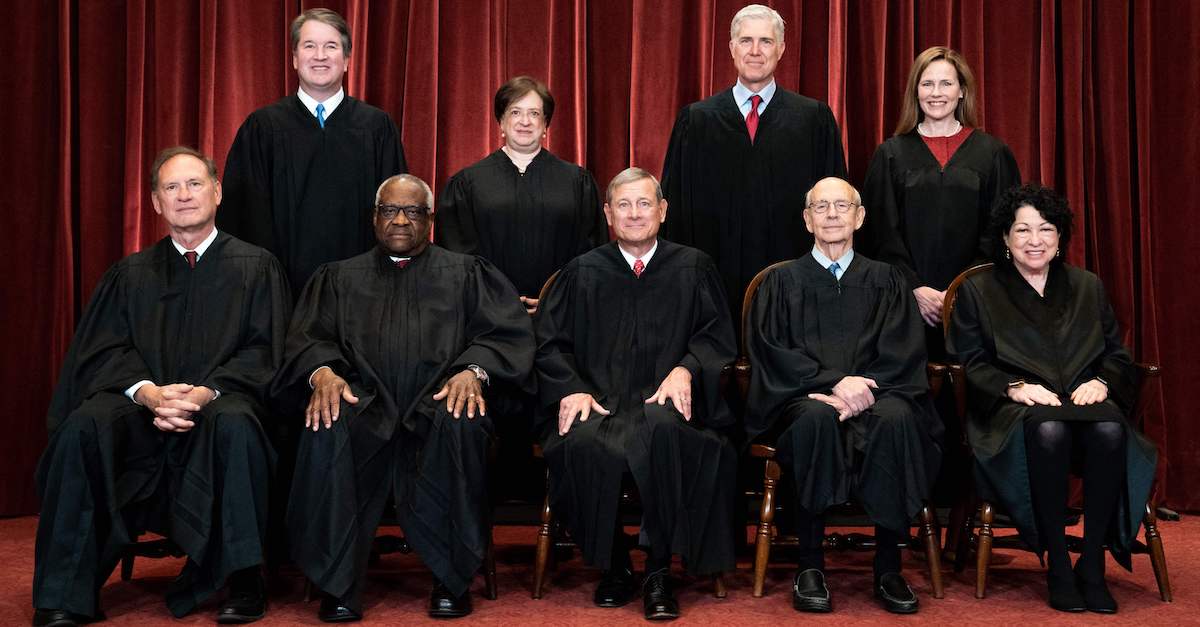
Seated from left: Associate Justice Samuel Alito, Associate Justice Clarence Thomas, Chief Justice John Roberts, Associate Justice Stephen Breyer and Associate Justice Sonia Sotomayor, standing from left: Associate Justice Brett Kavanaugh, Associate Justice Elena Kagan, Associate Justice Neil Gorsuch and Associate Justice Amy Coney Barrett pose during a group photo of the Justices at the Supreme Court in Washington, DC on April 23, 2021.
The Supreme Court of the United States handed down two unanimous decisions Monday — making the total a whopping four 9-0 decisions in a week’s time.
The first opinion released by SCOTUS on this morning was United States v. Palomar-Santiago, an immigration decision authored by Justice Sonia Sotomayor, in which the full court sided with the government and against the immigrant.
The unanimous court ruled against the Mexican national Refugio Palomar-Santiago, who was charged with criminal re-entry into the United States. Palomar-Santiago became a permanent U.S. resident in 1990, was deported in 1998, and was found living again in the U.S. in 2017. As a result of being found unlawfully on American soil, Palomar-Santiago was prosecuted for criminal re-entry.
The challenge before the Supreme Court focused on a change in legal classification that had potential to upend Palomar-Santiago’s criminal prosecution. The statute underlying the prosecution for criminal re-entry is 8 U.S.C. § 1326, and it requires prosecutors to prove that there was a prior removal order adjudicated by a federal immigration agency. In Palomar-Santiago’s case, there was such a prior removal order. However, the original basis for Palomar-Santiago’s deportation had been flawed.
Palomar-Santiago was convicted in California state court of felony DUI in 1988; at that time, the conviction was considered an “aggravated felony.” The status of the DUI crime, however, changed over time; the Supreme Court decided Leocal v. Ashcroft in 2004, ruling that as a non-violent offense, DUI did not constitute an “aggravated felony.”
Can Palomar-Santiago defend himself against the criminal re-entry charge on the grounds that his original removal had been invalid? All nine justices said no.
Although the Court acknowledged that this immigrant’s removal order “never should have issued,” that error alone was not enough to warrant a ruling in his favor. Rather, the criminal re-entry statute requires that a person wishing to challenge an underlying removal order must demonstrate three things: “(1) they have ‘exhausted any administrative remedies,’ (2) they were ‘deprived . . . of the opportunity for judicial review,’ and (3) ‘the entry of the order was fundamentally unfair.'” Palomar-Santiago did not meet those requirements — and the lower courts were not authorized to excuse them.
In a quick and direct eight-page decision, Justice Sotomayor dispensed with Palomar-Santiago’s arguments, stating simply, “The Court holds that each of the statutory requirements of §1326(d) is mandatory.”
Next, in Territory of Guam v. United States, the justices ruled in favor of Guam, allowing the island to pursue the collection of funding from the U.S. government to remediate environmental pollution on the island.
The case is the most recent chapter in a decades-old dispute between the U.S. Navy and the territory of Guam over a “280-foot mountain of trash” near the center of the island; it involves interpretation of the Comprehensive Environmental Response, Compensation and Liability Act (CERCLA) — known more commonly as the “Superfund” statute.
The Pacific island of Guam was ceded by Spain to the U.S. in 1899; its residents are U.S. citizens. Guam was governed by the U.S. Navy until December 1941, then seized by the Japanese after the attack on Pearl Harbor. Three years later, the U.S. recaptured Guam. Not long after, the Navy started dumping toxic waste into what became a 40-acre region known as the “Ordot Dump.” Guam itself took over complete control over the site and used it as a public landfill.
Congress enacted CERCLA in 1980, and it established liability for costs of remediating Superfund sites. Litigation between Guam and the U.S. ensued, as both had a hand in creating the conditions at the Ordot Dump. In 2004, the Environmental Protection Agency (EPA) and Guam entered into a settlement via consent decree. Under the terms, Guam would pay a civil penalty and close the dump. The consent decree was intended to settle all Ordot Dump-related claims between the parties.
Guam did not comply with the terms of settlement, leading to the court to appoint a receiver who did close the Ordot Dump in 2011. Guam then sued the U.S. Navy in 2017, hoping to force the U.S. to fund some of the costly cleanup. Guam claimed that the consent decree had actually settled a Clean Water Act case, not a CERCLA case. As a result, Guam maintained, CERCLA permits it to now seek contribution from the Navy for its part in creating the problem.
The justices sided with Guam. The Supreme Court reversed the lower court’s decision, ruling that despite the earlier consent decree, Guam does have the right to pursue contribution from the U.S. government.
Writing for the unanimous Court, Justice Clarence Thomas delivered the 12-page opinion. Thomas reasoned the fact that the portion of the applicable statute “is entitled ‘contribution’ is the first clue that it is concerned only with the distribution of CERCLA liability.”
“A contribution suit does not exist in a vacuum, but rather is a tool for apportioning the burdens of a predicate ‘common liability’ among the responsible parties,” Thomas wrote.
The high court’s decision means that the case will now be remanded to the lower courts to determine what share the U.S. government must contribute to the remediation efforts.
[image via Erin Schaff/POOL/AFP via Getty Images]
Have a tip we should know? [email protected]